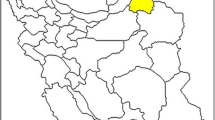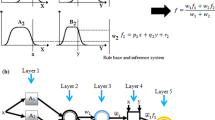Abstract
This paper aims to employ and compare four methods of neural network (NN), support vector regression (SVR), least squares support vector regression (LSSVR) and adaptive neuro-fuzzy inference system (ANFIS) for modeling the time series behavior of the meteorological and the remotely sensed (RS) drought indices of the eastern district of Isfahan during 2000–2014. The data used in the paper are the normalized difference vegetation index (NDVI) and the land surface temperature time series of MODIS satellite and the rainfall time series of TRMM satellite. Then, three RS drought indices namely vegetation condition index, NDVI deviation index and temperature vegetation index and three meteorological drought indices namely 3-month SPI, 6-month SPI and 12-month SPI are generated by the data. Afterward, based on the correlation coefficient between the RS and the meteorological drought indices, three indices are chosen as candidate indices for monitoring the drought severity of the study area. After modeling the time series behavior of these indices by the aforementioned methods, the results indicate that the SVR has the highest and the NN has the lowest efficiency among all the methods. In addition, the performance speed of the LSSVR and then the ANFIS is the highest. At the end of the paper, a fuzzy inference system (FIS) is presented based on the candidate indices to monitor the drought severity at spring and summer of 2000–2014. According to the results of the designed FIS, the spring status is normal in all years except 2000 and 2011 (moderate drought) and the summer status is severe drought in all years except 2000, 2010, 2011 and 2014 (moderate drought).






Similar content being viewed by others
References
Agwata JF (2014) A review of some indices used for drought studies. Civ Environ Res 6(2):14–21
Barua S, Perera BJC, Ng AWM, Tran D (2010) Drought forecasting using an aggregated drought index and artificial neural networks. J Water Clim Change 1:193–206
Berhan G, Hill S, Tadesse T, Atnafu S (2011) Using satellite images for drought monitoring: a knowledge discovery approach. J Strateg Innov Sustain 7(1):135–153
Bhuiyan C, Singh RP, Kogan FN (2006) Monitoring drought dynamics in the Aravalli Region (India) using different indices based on ground and remote sensing data. Int J Appl Earth Obs Geoinf 8:289–302
Chen CC, Lin CJ (2010) LIBSVM: A library for support vector regressions. http://www.csie.ntu.edu.tw/~cjlin/libsvm
Collier MW, McGovern A (2008) Kernels for the investigation of localized spatiotemporal transitions of drought with support vector regressions. In: IEEE international conference on data mining workshops, pp 359–368
Dastorani MT, Afkhami H, Sharifidarani H, Dastorani M (2010) Application of ANN and ANFIS models on dryland precipitation prediction (case study: Yazd in central Iran). J Appl Sci 10(20):2387–2394
Dastorani MT, Afkhami H, Borroni B (2011) Application of artificial neural networks on drought prediction in Yazd (Central Iran). Desert 16:39–48
Du L, Tian Q, Yu T, Meng Q, Jansco T, Udavrdy P, Huang Y (2013) A comprehensive drought monitoring method integrating MODIS and TRMM data. Int J Applied Earth Obs Geoinf 23:245–253
Fatehi Marj A, Meijerink AMJ (2011) Agricultural drought forecasting using satellite images, climate indices and artificial neural network. Int J Remote Sens 32(24):9707–9719
http://neo.sci.gsfc.nasa.gov/. Accessed Dec 2014
Jain SK, Keshri R, Goswami A, Sarkar A (2010) Application of meteorological and vegetation indices for evaluation of drought impact: a case study for Rajasthan, India. Nat Hazards 54:643–656
Jalili M, Gharibshah J, Ghavami SM, Beheshtifar MR, Farshi R (2014) Nationwide prediction of drought conditions in iran based on remote sensing data. IEEE Trans Comput 63(1):90–101
Keskin ME, Terzi O, Taylan ED, Kucukyaman D (2009) Meteorological drought analysis using data-driven models for the Lakes District, Turkey. Hydrol Sci J Sci Hydrol 54(6):1114–1124
Keskin ME, Terzi O, Taylan ED, Kucukyaman D (2011) Meteorological drought analysis using artificial neural networks. Sci Res Essays 6:4469–4477
Khosravi I, Mohammad-Beigi M (2014) Multiple classifier systems for hyperspectral remote sensing data classification. J Indian Soc Remote Sens 42(2):423–428
Kogan FN (1997) Global drought watch from space. Bull Am Meteorol Soc 78:621–636
Kurkova V (1992) Kolmogorov’s theorem and multilayer neural networks. Neural Netw 5(3):501–506
Lambin EF, Ehrlich D (1996) The surface temperature-vegetation index space for land cover and land-cover change analysis. Int J Remote Sens 17(3):463–487
Liu WT, Kogan FN (1996) Monitoring regional drought using the vegetation index. Int J Remote Sens 17(14):2761–2782
Mishra AK, Desai VR (2006) Drought forecasting using feed-forward recursive neural network. Ecol Model 198:127–138
Mishra AK, Singh VP (2010) A review of drought concepts. J Hydrol 391:202–216
Momeni M, Saradjian MR (2007) Evaluating NDVI-based emissivities of MODIS bands 31 and 32 using emissivities derived by day/night LST algorithm. Remote Sens Environ 106:190–198
Muthumanickam D, Kannan P, Kumaraperumal R, Natarajan S, Sivasamy R, Poongodi C (2011) Drought assessment and monitoring through remote sensing and GIS in western tracts of Tamil Nadu, India. Int J Remote Sens 32(18):5157–5176
Nikhbakht Shahbazi A, Heidarnejhad M (2012) Meteorological drought prediction in Karoon watershed using meteorological variables. Int Res J Appl Basic Sci 3(9):1760–1768
Orhan O, Ekercin S, Dadaser-Celik F (2014) Use of landsat land surface temperature and vegetation indices for monitoring drought in the Salt Lake Basin Area, Turkey. Sci World J 2014:1–11
Patel NR, Yadav K (2015) Monitoring spatio-temporal pattern of drought stress using integrated drought index over Bundelkhand region, India. Nat Hazards 2015(77):663–677
Qing C, Xiaoli Z, Kun Z (2012) Research on precipitation prediction based on time series model. In: 2012 International conference on computer distributed control and intelligent environmental monitoring, pp 568–571
Qiu L, Zhao M, Wei M (2011) Center approach grey BP neural network prediction model for years of drought occurrence in Xinzhou District of Wuhan City. In: 2011 5th International conference on bioinformatics and biomedical engineering, (iCBBE), pp 1–4
Quiring SM, Ganesh S (2010) Evaluating the utility of the vegetation condition index (VCI) for monitoring meteorological drought in Texas. Agric For Meteorol 150:330–339
Rahimzadeh-Bajgiran P, Shimizu Y, Hosoi F, Omasa K (2009) MODIS vegetation and water indices for drought assessment in semi-arid ecosystems of Iran. J Agric Meteorol 65(4):349–355
Rahimzadeh-Bajgiran P, Omasa K, Shimizu Y (2012) Comparative evaluation of the vegetation dryness index (VDI), the temperature vegetation dryness index (TVDI) and the improved TVDI (iTVDI) for water stress detection in semi-arid regions of Iran. ISPRS J Photogramm Remote Sens 68:1–12
Rojas O, Vrieling A, Rembold F (2011) Assessing drought probability for agricultural areas in africa with coarse resolution remote sensing imagery. Remote Sens Environ 115:343–352
Rulinda CM (2007) Mining drought from remote sensing images. M.Sc. Thesis, Geo-information Science and Earth Observation
Rulinda CM, Dilo A, Bijker W, Stein A (2012) Characterizing and quantifying vegetative drought in East Africa using fuzzy modelling and NDVI data. J Arid Environ 78:169–178
Sadri S, Burn DH (2012) Nonparametric methods for drought severity estimation at ungauged sites. Water Resour Res 48:1–10
Sahoo AK, Sheffield J, Pan M, Wood EF (2015) Evaluation of the tropical rainfall measuring mission multi-satellite precipitation analysis (TMPA) for assessment of large-scale meteorological drought. Remote Sens Environ 159:181–193
Samsudin R, Shabri A, Saad P (2010) A comparison of time series forecasting using support vector regression and artificial neural network model. J Appl Sci 10(11):950–958
Shabri A, Suhartono (2012) Streamflow forecasting using least-squares support vector machines. Hydrol Sci J 57(7):1275–1293
Shahabfar A, Ghulam A, Eitzinger J (2012) Drought monitoring in Iran using the perpendicular drought indices. Int J Appl Earth Obs Geoinf 18:119–127
Shahabfar A, Ghulam A, Conrad C (2014) Understanding hydrological repartitioning and shifts in drought regimes in Central and South-West Asia using MODIS derived perpendicular drought index and TRMM data. IEEE J Sel Top Appl Earth Obs Remote Sens 7(3):983–993
Shamsipour AA, Zewar-Reza P, Alavi Panah SK, Azizi G (2011) Analysis of drought events for the semi-arid central pains of Iran with satellite and meteorological based indicators. Int J Remote Sens 32(24):9559–9569
Sharma A (2006) Spatial data mining for drought monitoring: an approach using temporal NDVI and rainfall relationship. M.Sc. Thesis, Geo-information Science and Earth Observation
Shirmohammadi B, Moradi H, Moosavi V, Taei Semiromi M, Zeinali A (2013) Forecasting of meteorological drought using wavelet-ANFIS hybrid model for different time steps (case study: Southeastern Part of East Azerbaijan Province, Iran). Nat Hazards 2013(69):389–402
Song X, Saito G, Kodama M, Sawada H (2004) Early detection system of drought in East Asia using NDVI from NOAA AVHRR data. Int J Remote Sens 25(16):3105–3111
Srinivasan SP, Malliga P (2014) A conceptual framework for Jatropha seed yield estimation using adaptive neuro-fuzzy inference system (ANFIS) modelling. Int J Sustain Eng 4(2):183–191
Sur C, Hur J, Kim K, Choi W, Choi M (2015) An evaluation of satellite-based drought indices on a regional scale. Int J Remote Sens 36(22):5593–5612
Wang H, Hu D (2005) Comparison of SVM and LS–SVM for regression. In: International conference on neural networks and brain 2005. ICNN&B ‘05’, pp 279–283
Zargar A, Sadiq R, Naser B, Khan FI (2011) A review of drought indices. Environ Rev 19:333–349
Zhang P (2003) Time series forecasting using a hybrid ARIMA and neural network model. Neurocomputing 50:159–175
Zhang A, Jia G (2013) Monitoring meteorological drought in semiarid regions using multi-sensor microwave remote sensing data. Remote Sens Environ 138:12–23
Zhang X, Zhang T, Young AA, Li X (2014) Applications and comparisons of four time series models in epidemiological surveillance data. PLoS ONE 9(2):1–16
Zhou L, Zhang J, Wu J, Zhao L, Liu M, Lu A, Wu Z (2012) Comparison of remotely sensed and meteorological data-derived drought indices in Mid-Eastern China. Int J Remote Sens 33(6):1755–1779
Author information
Authors and Affiliations
Corresponding author
Additional information
The original version of this article was revised: A hyphen needed to be inserted in the last name of author Yaser Jouybari-Moghaddam.
An erratum to this article is available at http://dx.doi.org/10.1007/s11069-017-2879-2.
Rights and permissions
About this article
Cite this article
Khosravi, I., Jouybari-Moghaddam, Y. & Sarajian, M.R. The comparison of NN, SVR, LSSVR and ANFIS at modeling meteorological and remotely sensed drought indices over the eastern district of Isfahan, Iran. Nat Hazards 87, 1507–1522 (2017). https://doi.org/10.1007/s11069-017-2827-1
Received:
Accepted:
Published:
Issue Date:
DOI: https://doi.org/10.1007/s11069-017-2827-1




